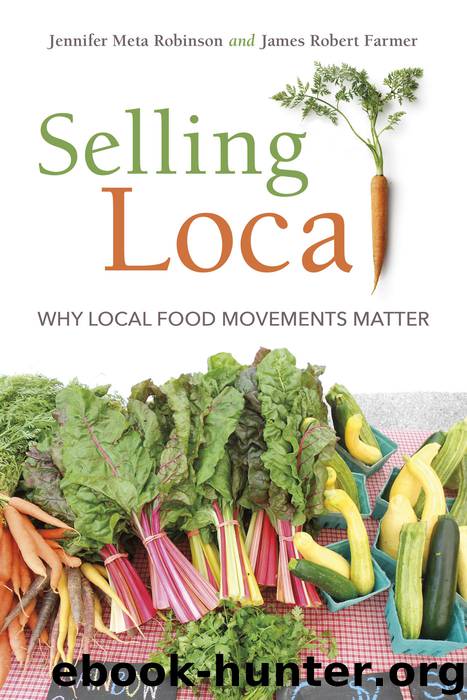Selling Local by Jennifer Meta Robinson

Author:Jennifer Meta Robinson [Robinson, Jennifer Meta]
Language: eng
Format: epub
ISBN: 9780253026989
Publisher: Indiana University Press
Published: 2017-01-15T07:00:00+00:00
Urban Agriculture
While the idealized farm may consist of rolling pastures with meandering cattle, an old red barn, fields of waving grain, and orchards capping the ridges, farming is increasingly cropping up between high-rise buildings, on old brownfields, and in abandoned lots where classic arts-and-crafts-style homes once stood. Urban agriculture includes the acts of cultivating/producing, processing, and distributing food in or immediately around cities, towns, and villages.40 According to the Urban Agriculture Network, its namesake is
an industry that produces, processes, and markets food, fuel, and other outputs, largely in response to the daily demand of consumers within a town, city, or metropolis, on many types of privately and publicly held land and water bodies found throughout intra-urban and peri-urban areas. Typically urban agriculture applies intensive production methods, frequently using and reusing natural resources and urban wastes, to yield a diverse array of land-, water-, and air-based fauna and flora, contributing to the food security, health, livelihood, and environment of the individual, household, and community.41
Importantly, urban agriculture in the United Sates is not just about food. Rather, it emerges from a nexus of food, social change, and economic movements occurring in cities. From it emerge substantial sustainability benefits that enhance goods and services provided by the ecosystem. These benefits include a smaller carbon footprint for food, improved air quality, water filtration and runoff control, a cleaner and an enhanced urban environment, and, thus, better human health. According to Rich Pirog of the Leopold Center for Sustainable Agriculture, the typical American meal contains ingredients from about five different countries, not including the United States.42 The same study found that, on average, local apples were transported only 61 miles, while the conventional equivalents were being delivered from 1,726 miles away. This change in distance means that food produced and consumed locally requires from four to seventeen times less fuel for shipping than conventional produce. In addition to lowering food miles, urban agriculture promotes improved carbon sequestration in plants and soil; improves hydrology by directing water from streets and storm sewers to capture systems and urban “fields”; promotes the absorption of ozone and particulates by plants, especially trees; decontaminates soils; and provides buffers that reduce noise pollution. Scaled up for the size of the population in urban areas, growing and consuming locally can quickly add up to substantial reductions in environmental impacts and offer an assortment of ecosystem services to compensate for other deleterious effects resulting from city life.
Social benefits also accrue from the urban agriculture movement. As in many environments, marginalized urban populations often face increased barriers to healthy food. Agriculture in cities is now being used as a social program to enhance food security and the sovereignty of urban dwellers through community-based food distribution outlets, garden spaces for community members, neighborhood networking, and small business development. Alison Hope Alkon describes a survey of the West Oakland and North Berkeley farmers’ markets that shows that about a third of all those surveyed indicated they see friends and neighbors at the market during nearly every visit.
Download
This site does not store any files on its server. We only index and link to content provided by other sites. Please contact the content providers to delete copyright contents if any and email us, we'll remove relevant links or contents immediately.
International Integration of the Brazilian Economy by Elias C. Grivoyannis(90610)
The Radium Girls by Kate Moore(11921)
Turbulence by E. J. Noyes(7935)
Nudge - Improving Decisions about Health, Wealth, and Happiness by Thaler Sunstein(7613)
The Black Swan by Nassim Nicholas Taleb(7009)
Rich Dad Poor Dad by Robert T. Kiyosaki(6398)
Pioneering Portfolio Management by David F. Swensen(6226)
Man-made Catastrophes and Risk Information Concealment by Dmitry Chernov & Didier Sornette(5921)
Zero to One by Peter Thiel(5684)
Secrecy World by Jake Bernstein(4640)
Millionaire: The Philanderer, Gambler, and Duelist Who Invented Modern Finance by Janet Gleeson(4374)
The Age of Surveillance Capitalism by Shoshana Zuboff(4207)
Skin in the Game by Nassim Nicholas Taleb(4161)
Bullshit Jobs by David Graeber(4094)
The Money Culture by Michael Lewis(4073)
Skin in the Game: Hidden Asymmetries in Daily Life by Nassim Nicholas Taleb(3929)
The Dhandho Investor by Mohnish Pabrai(3698)
The Wisdom of Finance by Mihir Desai(3649)
Blockchain Basics by Daniel Drescher(3495)
